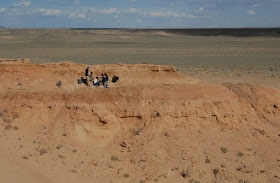 |
| Gobiraptor minutus
Lee, Lee, Chinsamy, Lü, Barsbold & Tsogtbaatar, 2019
|
Abstract
Recent discoveries of new oviraptorosaurs revealed their high diversity from the Cretaceous Period in Asia and North America. Particularly, at the family level, oviraptorids are among the most diverse theropod dinosaurs in the Late Cretaceous of Mongolia and China. A new oviraptorid dinosaur Gobiraptor minutus gen. et sp. nov. from the Upper Cretaceous Nemegt Formation is described here based on a single holotype specimen that includes incomplete cranial and postcranial elements. The most prominent characters of Gobiraptor are its thickened rostrodorsal end of the mandibular symphysis and a rudimentary lingual shelf on each side of the dentary. Each lingual shelf is lined with small occlusal foramina and demarcated by a weakly developed lingual ridge. This mandibular morphology of Gobiraptor is unique among oviraptorids and likely to be linked to a specialized diet that probably included hard materials, such as seeds or bivalves. The osteohistology of the femur of the holotype specimen indicates that the individual was fairly young at the time of its death. Phylogenetic analysis recovers Gobiraptor as a derived oviraptorid close to three taxa from the Ganzhou region in southern China, but rather distantly related to other Nemegt oviraptorids which, as the results of recent studies, are also not closely related to each other. Gobiraptor increases diversity of oviraptorids in the Nemegt Formation and its presence confirms the successful adaptation of oviraptorids to a mesic environment.
Systematic paleontology
Dinosauria Owen, 1842
Theropoda Marsh, 1881
Maniraptora Gauthier, 1986
Oviraptorosauria Barsbold, 1976
Oviraptoridae Barsbold, 1976
Gobiraptor minutus gen. et sp. nov.
Etymology: The generic name Gobiraptor is a combination of ‘Gobi’ which refers to the Gobi Desert where the holotype specimen was found and ‘raptor’ which is Latin for thief. The specific name ‘minutus’ is Latin for small and refers to the small size of the holotype specimen.
Holotype: The holotype specimen (MPC-D 102/111) (Figs 2–4, S2 and S3 Figs) consists of mostly incomplete cranial and postcranial elements including ventral parts of the premaxillae and maxillae, a tip of the right jugal, fused vomer, parts of articulated pterygoids and ectopterygoids, incomplete right palatine, central part of the left postorbital, partial right quadrate and quadratojugal, incomplete lower jaw, with most of its elements broken, the last sacral vertebra which is articulated with the two proximalmost caudal vertebrae, articulated but incomplete proximal caudal vertebrae, fragments of chevrons, partial right scapula and humerus, incomplete pelvic girdles, nearly complete both femora, complete left metatarsus with distal tarsals 3 and 4, incomplete left pedal digits I, III, and IV, and several unidentified fragments. MPC-D 102/111 was also found with other theropod skeletons including postcranial elements of alvarezsaurids and larger oviraptorids.
Type locality and horizon: Altan Uul III, Ömnögovi Province, Mongolia (Fig 1, S1 Fig). Upper Cretaceous Nemegt Formation.
Diagnosis: Gobiraptor minutus is an oviraptorid dinosaur diagnosed by the following unique set of characteristics (autapomorphies are marked with an asterisk): a flat articular surface for the quadratojugal on the quadrate*; rostrocaudally elongate dentary rostral to the external mandibular fenestra; extremely thickened rostrodorsal end of the mandibular symphysis with a caudal expansion of its dorsal surface *; a rudimentary lingual triturating shelf on each dentary bearing small occlusal foramina*; a weakly developed lingual ridge on each lingual shelf*; absence of any prominent symphyseal ventral process of the dentary; coronoid bone present; the rostral end of the coronoid bone wedging into the ventral surface of the dorsal ramus of the dentary*; cranial trochanter of the femur separated from the greater trochanter with a distinct furrow between them.
....
Conclusions:
Gobiraptor minutus gen. et sp. nov. is a new derived oviraptorid represented by an incomplete skeleton including both cranial and postcranial elements. Gobiraptor is primarily distinguished from other oviraptorids by its dentary with the extremely thickened rostrodorsal end of the mandibular symphysis, lingual ridges and lingual shelves bearing occlusal foramina. The unique morphology of the mandible of Gobiraptor is probably closely related to a crushing-related feeding style and a specialized diet, which may have incorporated hard seeds or shelled organisms. Although Gobiraptor was recovered from the Nemegt Formation, its phylogenetic position showed a close relationship with three Ganzhou oviraptorids. The distant relationships among the Nemegt oviraptorids on the phylogenetic tree were reaffirmed in this study. Therefore, it is highly unlikely that the evolution of these unusually diverse animals was facilitated by a simple sympatric speciation. The presence of Gobiraptor in the Nemegt Formation, together with occurrences of other oviraptorids, also indicates that abundant oviraptorids lived in mesic environments and they were one of the most diverse and successful groups of dinosaurs in the Nemegt region.
Sungjin Lee, Yuong-Nam Lee , Anusuya Chinsamy, Junchang Lü†, Rinchen Barsbold and Khishigjav Tsogtbaatar. 2019. A New Baby Oviraptorid Dinosaur (Dinosauria: Theropoda) from the Upper Cretaceous Nemegt Formation of Mongolia. PLoS ONE. 14(2): e0210867. DOI: 10.1371/journal.pone.0210867
New oviraptorosaur species discovered in Mongolia phys.org/news/2019-02-oviraptorosaur-species-mongolia.html via @physorg_com







